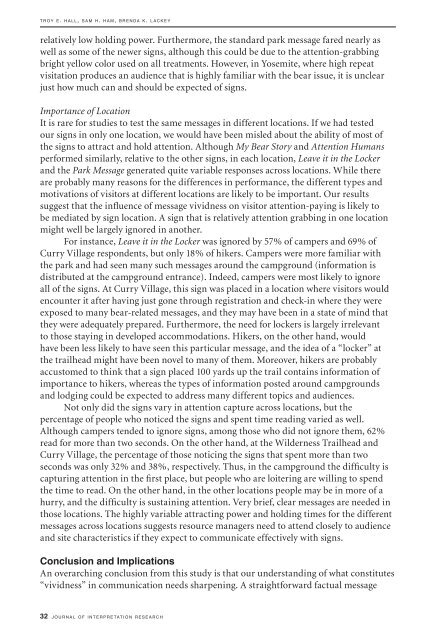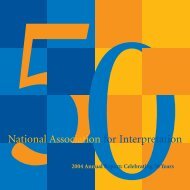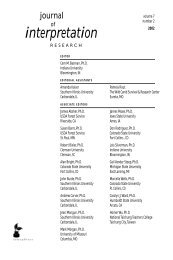interpretation
Volume 15, Number 1 - National Association for Interpretation
Volume 15, Number 1 - National Association for Interpretation
Create successful ePaper yourself
Turn your PDF publications into a flip-book with our unique Google optimized e-Paper software.
t r o y e. h a l l , s a m h. h a m , b r e n d a k. l a c k e y<br />
relatively low holding power. Furthermore, the standard park message fared nearly as<br />
well as some of the newer signs, although this could be due to the attention-grabbing<br />
bright yellow color used on all treatments. However, in Yosemite, where high repeat<br />
visitation produces an audience that is highly familiar with the bear issue, it is unclear<br />
just how much can and should be expected of signs.<br />
Importance of Location<br />
It is rare for studies to test the same messages in different locations. If we had tested<br />
our signs in only one location, we would have been misled about the ability of most of<br />
the signs to attract and hold attention. Although My Bear Story and Attention Humans<br />
performed similarly, relative to the other signs, in each location, Leave it in the Locker<br />
and the Park Message generated quite variable responses across locations. While there<br />
are probably many reasons for the differences in performance, the different types and<br />
motivations of visitors at different locations are likely to be important. Our results<br />
suggest that the influence of message vividness on visitor attention-paying is likely to<br />
be mediated by sign location. A sign that is relatively attention grabbing in one location<br />
might well be largely ignored in another.<br />
For instance, Leave it in the Locker was ignored by 57% of campers and 69% of<br />
Curry Village respondents, but only 18% of hikers. Campers were more familiar with<br />
the park and had seen many such messages around the campground (information is<br />
distributed at the campground entrance). Indeed, campers were most likely to ignore<br />
all of the signs. At Curry Village, this sign was placed in a location where visitors would<br />
encounter it after having just gone through registration and check-in where they were<br />
exposed to many bear-related messages, and they may have been in a state of mind that<br />
they were adequately prepared. Furthermore, the need for lockers is largely irrelevant<br />
to those staying in developed accommodations. Hikers, on the other hand, would<br />
have been less likely to have seen this particular message, and the idea of a “locker” at<br />
the trailhead might have been novel to many of them. Moreover, hikers are probably<br />
accustomed to think that a sign placed 100 yards up the trail contains information of<br />
importance to hikers, whereas the types of information posted around campgrounds<br />
and lodging could be expected to address many different topics and audiences.<br />
Not only did the signs vary in attention capture across locations, but the<br />
percentage of people who noticed the signs and spent time reading varied as well.<br />
Although campers tended to ignore signs, among those who did not ignore them, 62%<br />
read for more than two seconds. On the other hand, at the Wilderness Trailhead and<br />
Curry Village, the percentage of those noticing the signs that spent more than two<br />
seconds was only 32% and 38%, respectively. Thus, in the campground the difficulty is<br />
capturing attention in the first place, but people who are loitering are willing to spend<br />
the time to read. On the other hand, in the other locations people may be in more of a<br />
hurry, and the difficulty is sustaining attention. Very brief, clear messages are needed in<br />
those locations. The highly variable attracting power and holding times for the different<br />
messages across locations suggests resource managers need to attend closely to audience<br />
and site characteristics if they expect to communicate effectively with signs.<br />
Conclusion and Implications<br />
An overarching conclusion from this study is that our understanding of what constitutes<br />
“vividness” in communication needs sharpening. A straightforward factual message<br />
32 j o u r n a l o f i n t e r p r e t a t i o n r e s e a r c h












